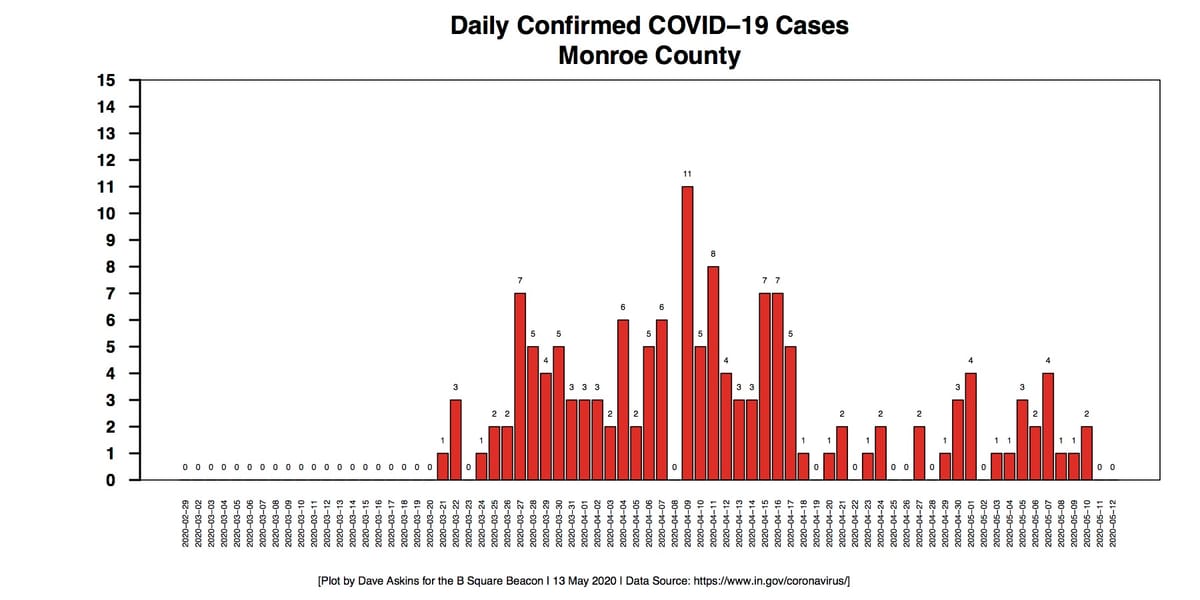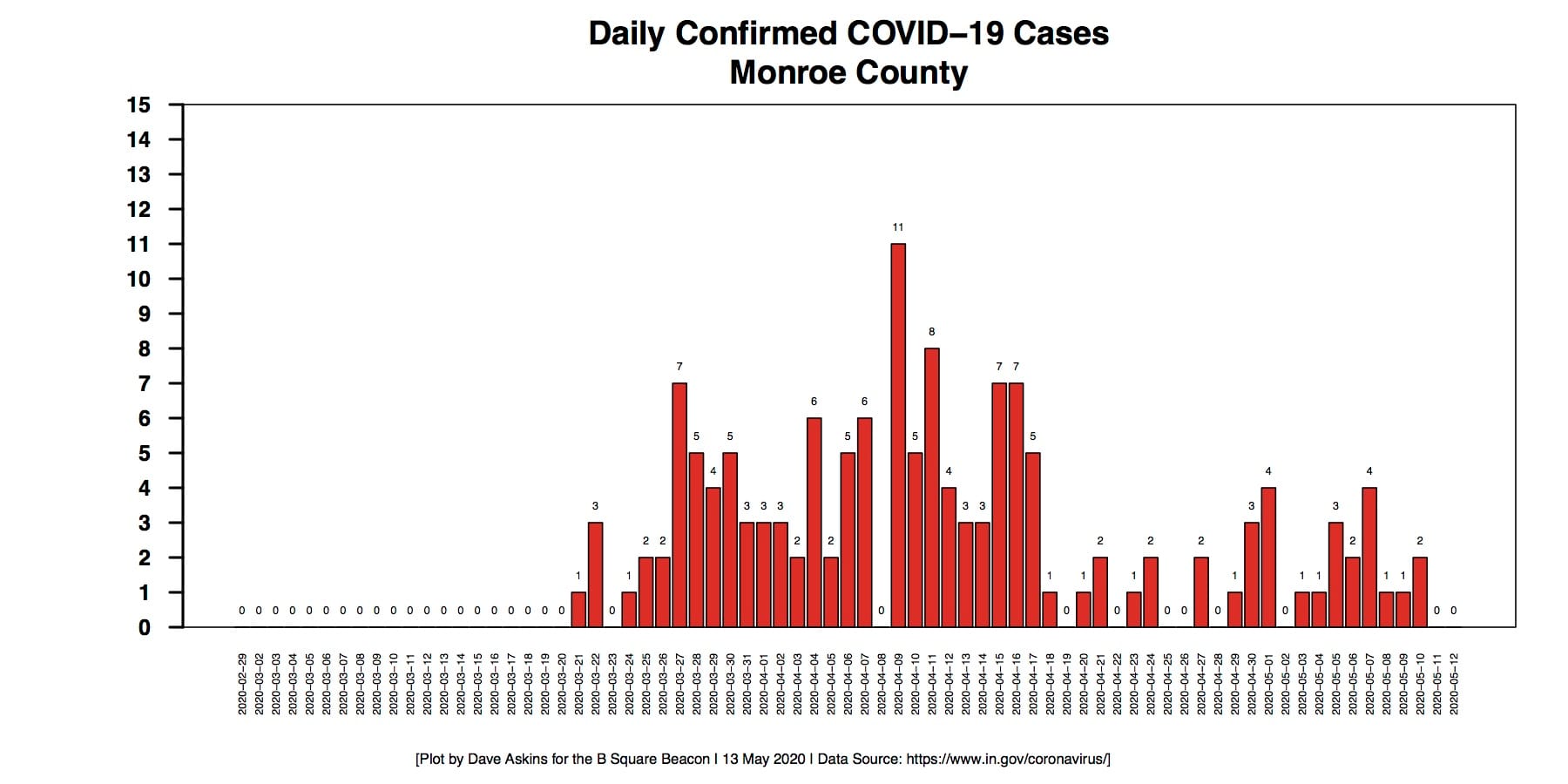“You are safest at home,” says Monroe County’s health administrator, but science plus art means re-opening start



Monroe County’s health administrator Penny Caudill said Wednesday that last week’s local health emergency order on COVID-19 would likely be replaced at week’s end with one that allows barbershops and hair salons to re-open and restaurants to offer dine-in service, starting Saturday, May 16. [Updated: May 14, 2020 at 4:35 p.m. The order has been issued.]
The county’s current order is stricter than Indiana governor Eric Holcomb’s “Back on Track” plan announced May 1.
The local order—which was also issued on May 1, and maintained the same kind of business closures and stay-at-home directives as the governor’s “Hunker Down, Hoosiers” order had—is set to expire at the end of the day on Friday.
The new local order is expected to be effective through May 31, Caudill said.
Caudill made the announcement at Wednesday morning’s county board of commissioners meeting. She said that the new order is still in draft form and could change if there are new developments between now and Friday.
The more than 100 people who joined the Zoom videoconference for the board of commissioners meeting were a measure of the high interest in a potential announcement from the county on the topic of re-opening.
Monroe County’s Saturday re-opening conditions mirror many of the governor’s “Stage 2” requirements. Among those is a requirement that restaurants operate at no more than 50-percent capacity. Business also must develop and post publicly a plan to “implement measures and institute safeguards to ensure a safe environment for their employees, customers, clients, and members.”
Business re-opening plans have to include, among other elements: an employee health screening process; enhanced cleaning and disinfecting protocols; enhanced ability of employees, customers and clients to wash their hands; ways to comply with six-foot physical distancing requirements; other measures, like wearing face coverings.
Monroe County now looks to be starting to synch up with the governor’s more aggressive re-opening plan. But during her announcement, as well as the impromptu press conference immediately after the board of commissioners meeting, the message that Caudill hammered the hardest was: “You’re safest at home.”
A key point on which local officials thought the governor’s plan was too aggressive, Caudill said, was the size of gatherings allowed.
The corrected local order from Monroe County on May 1 continued to limit gatherings to no larger than 10 people. The initial version of the order had said 25 people. The local order that’s expected in the next day or so will bump the number to 25. The size of allowable gatherings had been subject to a lot of discussion, Caudill said.
Caudill said that the new order would ask that religious services not be held inside until June—it’s not a requirement, but a request, she said.
Caudill is looking to the community for support and participation in maintaining good hand hygiene, physical distancing, and wearing face coverings when it’s not possible to maintain six feet of distance.
“If we move slowly, we can move forward more than we move back,” Caudill said. The reference to a “move back” means she’s holding open the possibility of reverting to stricter measures, if they’re needed.
One of the Centers for Disease Control “gating criteria” for reopening involves robust testing capability. The provision of enhanced testing in Monroe County, provided by a partnership between the state’s department of health OptumServe Health Services, is one of the elements that factored into Monroe County’s decision.
On Wednesday, Caudill said OptumServe testing in Monroe County would not be deployed on Wednesday as earlier hoped—due to some logistical details that had to be sorted out locally. Now it’s looking like Friday (May 15) for the start of the more enhanced testing, Caudill said.
OptumServe will make available as many as 132 tests a day. Through the third week of April, Monroe County ranged between 30 and 60 tests a day. In the last two weeks, the number of tests per day in Monroe County has averaged around 60.
Asked on Wednesday what trends pointed towards reopening, instead of continuing the same strict precautions, Caudill allowed that it might seem “a little convoluted”—saying that in addition to science, there was a “little bit of art in the mix, too.” Some of the decision making involved conversations with people in the community and the weighing of qualitative, anecdotal information as well as quantitative information, Caudill said.
Caudill said local health officials will continue to watch the state health department’s dashboard for trends in confirmed cases and hospital capacity—specifically the number of available ICU beds and ventilators.
The noon update to the dashboard on Wednesday marked the second day in a row that no new confirmed COVID-19 cases were reported for Monroe County.

As of Wednesday, for Monroe County, the last six weeks worth of daily averages for 14-day periods in succession were: 4.4, followed by 2.0, and then an average of 1.64 confirmed cases per day.
On Wednesday, Monroe County reported an addition death due to COVID-19, bring the total to 10.
In addition to numbers of confirmed cases, one of the Centers for Disease Control “gating criteria” is the percentage of positive tests. Percentage of positives been a good trend for Monroe County—it’s been downward. In mid-April the cumulative percentage of positive tests in Monroe County peaked at around 13 percent. As of Sunday that figure stood at 8 percent.
On Wednesday, Caudill said that if increased testing capacity showed an increase to, say, 10 percent positives of all tests, then local health officials would trying to understand why.
Caudill said on Wednesday that Monroe County would be using the improved contact tracing that’s available through a state health department partnership with Maximus. It includes the hire of 500 people statewide and setting up a call center. Contact tracing is key to curbing the spread of the virus, because it ensures that people who’ve been in contact with people who tested positive are notified, so they can isolate themselves.
Caudill said local health officials would use contact tracing to monitor for hot spots: Did lots of people who have positive tests all visit the same location?
Asked how local officials plan to enforce compliance with the 25-person limit on gatherings, or the public posting of a re-opening plan by businesses, Caudill said they would rely mostly on complaints. Police and health officials can’t be everywhere, she said.
The partial synching with the governor’s “Back on Track” plan has the advantage that local officials can more easily tap state resources, like the Alcohol & Tobacco Commission (ATC) for enforcement, Caudill said.




Comments ()